2003 Everglades Challenge
By Doug Cameron (aka RidgeRunner)
It's an overcast morning with an east to east northeast wind at
around ten knots. Assembled in the dawn light on the beach at Mullet Key in
Fort Desoto Park on the north side of Tampa Bay are fifty-odd sailors and
paddlers and their small craft. There is a lot of socializing and picture
taking and saying goodbye to families and friends. At seven we will all launch
for the Third Annual Water Tribe Everglades Challenge.
|
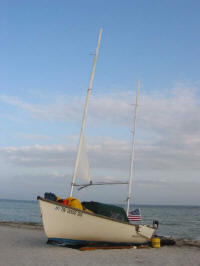
|
Billed as the toughest small boat race on earth, the Everglades
Challenge sprang like Minerva from the mind of Steve Isaac, called Chief by
members of the Water Tribe. The idea is to approximate the challenges one would
encounter on an expedition adventure, carrying your food and water and all the
necessary safety gear for the trip. (You are allowed to carry money and to buy
things, like a meal or a jug of water, from the "natives," but no support crews
are allowed.) The first two races were plagued with bad weather, and only 30
percent of the paddlers and sailors finished. The whole thing is run through a
web site, WaterTribe.com,
and the site was getting over 18,000 hits a day just before the start.
Publicity has just begun to catch up with the race, including articles in Canoe
& Kayak, National Geographic's Adventure, Paddler, and a long article in
Sea Kayaker magazine.
The March, 2003 race drew competitors from Hungary and England and
as far away as Michigan and Colorado. Assembled on the beach on Saturday
morning, March 8, were expedition sea kayaks, several Kruger single and double
expedition canoes, a proa, an outrigger canoe, Kevlar racing open canoes, a
homemade outrigger sailing canoe made from the hull of a Hobie catamaran, a 9
foot pram, a rather radical homemade 14 foot sharpie sailboat with a Chinese
yuloh sweep oar, two expedition Laser sailboats, a homemade wooden lapstrake
canoe, a 1960's Olympic racing catamaran, and my boat, a 1983 Sea Pearl 21
leeboard cat ketch based on a Francis Herreshoff whale boat.
The participants were equally diverse: several grandfathers
(including me), Russian and Polish immigrants, fish biologists and resource
managers from the Everglades National Park, medical doctors, entrepreneurs,
software authors, a megayacht designer, graduate students, boat builders, sea
kayak instructors, and school teachers. 34 were in the 300 mile Challenge; the
rest were in the 60-mile "marathon" to Checkpoint 2 at Placida (60 miles). We
all had tribal names, much like CB "handles." Mine was RidgeRunner, my handle
when I drove trucks for Blue Hole Canoes to supplement my school teacher's
income. A few were flat-out racers, but most just wanted to complete the
Challenge, a noble goal in light of the high attrition rate of previous years.
|
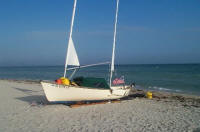
Ready for the Start
|
We had assembled the afternoon before the Challenge in the picnic
shelter on the beach to have our required equipment inspected and to load our
boats. Besides cell phones and marine radios, we were required to have
emergency locator beacons (EPIRBs), hypothermia kits, stove and cook kits, cold
weather camping equipment, and several other items designed to keep us safe.
There was also a "24 hour rule," which required us to check in every 24 hours
if we had not stopped by one of the four check points during the previous day.
Now it was Saturday morning. We had finished the prerequisite
photos and were ready to go. There was a sea haze in the air. The tide would be
going out for another hour, then we would be going "upstream" to get out of
Tampa Bay while it filled back up. A large freighter was in the shipping
channel a mile offshore.
|
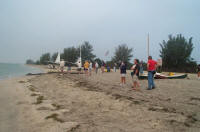
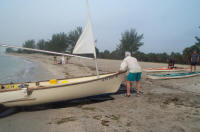
"Muscling" Off the Beach
|
At exactly seven o'clock, Chief said, "go," and everyone started
for the water. Some were in a big hurry, considering it would take the winner
three or four days to reach the end, and we all were allowed eight and a half
days to finish. Matt Layden's ungainly- looking Paradox and my Sea Pearl were
among the last to leave the beach, but we were all underway by 8 AM. (One
commentator on the WaterTribe.com
discussion forum said of my launch: "RidgeRunner, "muscled" his Sea Pearl off
the beach. [He didn't notice that the boat was on a plastic "slip-n-slide."] It
wasn't pretty but he succeeded inch by inch.")
It looked like a sailing race with the following winds. Many of the
canoes and kayaks sported sails. Some headed for the inside route on the
Intracoastal Waterway to the east of Anna Maria Island, and some pointed toward
the outside route on the open Gulf of Mexico. I chose the outside route,
planning to go well offshore to avoid the northbound alongshore current along
Anna Maria. I maintained my southwesterly heading for quite a while to avoid
the tidal waves and disturbed water in the shallows behind Passage Key,
important information I had gained during a scouting trip last year (We don't
have tides and waves on the inland TVA lakes where I do most of my sailing.).
Even so, I took one significant wave over the bow – from now on I'll keep the
cockpit cover closed! One kayak capsized behind Passage Key, but Matt rescued
him and towed him to Anna Maria Island, an action that added considerably to
his positive karma.
Winds slowly shifted to the south, but we had a fast sail all the
way to Sarasota. I was very impressed at how dry and stable the Sea Pearl was.
I had been a bit frightened about how she would perform, even though Sea Pearls
had made significant voyages in the past. All of my offshore sailing had been
in large cruising sailboats longer than 33 feet. This boat seemed vary small
and the sea seemed very large. I had gone outside, anyway, for the adventure
and the wind and the freedom from tides and power boat wakes.
Around three in the afternoon, off Sarasota, I caught up with Matt
in his box-like Paradox with its lug sail and no keel or centerboard. I was
clearly faster on a reach, but I eased the sheets and talked with him for a few
minutes. As the winds began to die, he set up his yuloh and I got out my oars.
That was the last I saw of Matt (who eventually won the race). He would be 9
hours ahead of me by the first checkpoint.
After an hour of rowing, my butt hurt from the board I used as a
rowing seat. An old shoulder injury was resurrecting itself and I was covered
with sweat. There was less than an hour to sundown, so I decided it was time to
heave-to to fix supper, prepare for darkness, and wait for the wind to return.
It wasn't worth injury to keep rowing, and I was only going 2 ½ knots.
As much as possible, I made it a point to go through a changeover
ritual at dusk and dawn. At night I took a baby wipes "bath" to clean the
sunscreen and sweat from my body, cooked supper, refilled the water bottles in
the cockpit, replenished the snack supply in the cockpit, took off my dark
glasses and cleaned them, got out the boat's running lights, changed batteries
in the GPS, and changed into Capilene® and windbreaker for the night sail. I
also called home to satisfy the 24 hour rule. Ann (my wife) would email Sandy,
Chief's wife, who maintained the web site and kept track of us all (thanks,
Sandy). In the mornings I reversed the process. I cooked breakfast (coffee and
oatmeal), stowed the running lights, refilled cockpit water and snacks, changed
into light, long- sleeved clothes and big straw hat, applied sunscreen, and put
on dark glasses.
This routine made sure that I was taking care of myself, and it
gave me time to take stock – the time spent sailing gave little time to do
things, though there was plenty of time to think. I once heard someone mention
the "hegemony of the tiller," and that was my experience – I couldn't leave the
helm unattended for long or the boat would begin to go its own way.
There was still no wind after sundown, so I lay down on the boat
cushions and slept, wondering whether there would be enough wind this week to
finish the race. 300 miles divided by eight days meant about 40 miles a day,
and I was watching that goal slip from me. I dozed off on the flat seas with a
gentle swell from the west.
About two in the morning a southwest wind began to fill in. It was
on the nose, so I would have to tack, but I had to use every breath of wind if
I was to finish. Sailing at night also made me a little nervous, but the charts
showed no dangers. I couldn't watch the sails for proper shape, and the waves
were difficult to see and anticipate in the misty darkness after moonset.
Everything was wet from condensation, including the compass lens. I could see
two shrimp boats working about two miles farther out, and they would be off my
bow the rest of the night.
I got into checkpoint one, on Snake Island in Venice Inlet, at 8
AM. I was the last boat to come in (There was one behind me, but he dropped
out.). I signed in, got a cup of coffee and sausage and biscuit at the
fisherman's stand at the inlet, and was on my way in a half hour.
The weather called for southeast winds at fifteen knots. This would
be on the nose again, but the Intercoastal Waterway became a trench in this
section, and I needed room to tack. As I went outside, I passed two sailors in
smaller boats coming back in. They both told me it was too rough for them. More
anxiety.
The second day was the day to regain confidence in my ability and
the boat's seaworthiness. The winds increased slowly to periods of over 20
knots. Waves were three to four feet, and the seas were occasionally streaky as
wind lifted foam from whitecaps.
The boat performed well. When the lee rail began to dip below the
surface, I would heave to and reef. The Sea Pearl is particularly strong in
this department. If you sheet in the mizzen and let go of the tiller and the
main sheet, she will round up, bow into the wind, and gently move backward.
This allows the crew to reef the sails and do other vital tasks. The sails reef
by rolling them around the masts, so reefing is easy and allows for many
options. I would take advantage of these features several times during the day.
After five or six long tacks and a couple of stops for reefing, the
shore began to fall away to the East and I was able to stay on a starboard tack
for five or six hours. Around five thirty, I turned away from the wind and
surfed into Gasparilla Pass on two foot breaking waves. As soon as I cleared
the white water, I hove to, threw out an anchor, and lowered the masts for the
passage under the low bridge (It was twelve feet, according to the charts, and
the tops of my masts were 20 feet off the water.).
|
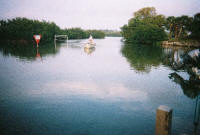
|
Clearing the bridge, I raised the main and ran like a cat boat to
the low trestle at Placida. Then I lowered the main mast again and paddled like
a Venetian gondolier into the checkpoint at Grand Tours. I had been sailing
since two in the morning, and I needed rest. Race Manager SandDollar and
Marathon sailor, Draco, greeted me, as did Chief, who was preparing to leave
for a night's paddling. I was no longer last and I now believed that I could
finish, but the wind was dying, and I needed rest. The GPS said that it had
taken 93 statute miles to get the 60 miles to Placida because of all the
tacking.
After a refreshing shower, and clean clothes, I joined Draco for a
dinner at a local seafood restaurant, where ZigZag Wanderer joined us. The
conversation was informative and assuring. Draco and her husband, Vanman (who
won the first Challenge and would finish this race second in his expedition
Laser), had experienced many small boat sailing adventures from Patagonia to
Labrador. ZigZag is a fisheries biologist for Everglades National Park, sailing
a Kruger canoe with a Balogh sail rig. He had interesting information about
Cape Romano Shoals, an area I was planning on avoiding.
After dinner, we returned to find AndrewsCanoes and Wanderer had
arrived. We all settled down in the air conditioned bunk house as thunderstorms
pelted the tin roof.. It had been a very full two days!
We all rose in the dark around 5:30, and soon the picnic tables at
Grand Tours sported camp stoves cooking breakfast and AndrewsCanoes fixing his
broken mast. Wayfarer was wrestling with whether to go on – his sleek racing
outrigger canoe was bogged down with all of the gear and wasn't going too fast.
In spite of our encouragement, he decided to pack it in. The rest of us
prepared to go, discussing whether to go inside through Pine Island Sound or
outside to the Gulf. The inside was a bit shorter, but the outside promised
better breezes, and the favorable north wind was filling in.
By 7:30 I was on my way, with ZigZagWanderer not far ahead. We
raised masts after the low trestle and were on our way in light northerly
breezes. I was only doing 2 or 3 miles per hour, and ZigZag stayed about a mile
in front. Boat traffic was heavy, and, even though my little boat was outside
of the channel, I was constantly rocked violently by powerboat wakes.
As we got to Boca Grande pass, ZigZag headed outside. The forecast
called for light winds, so I stayed inside on the Intercoastal Waterway through
Pine Island Sound. The inside route here is a little shorter, and I had read
about Pine Island Sound in sailing magazines. The wind filled in to 10-15 knots
off the stern quarter, and I broad reached all day at 5 to 7 knots. With this
increased pressure on the sails, the almost constant traffic of large
motorboats did not rock me violently as it did in Gasparilla Sound, but I
missed the light boat traffic on the outside. By 6 PM I passed under the bridge
between Sanibel Island and Fort Myers. I pulled up behind an island on the
causeway to fix supper, prepare for night, and call in my position report.
The night before I had used incandescent bow and stern lights
powered by AA batteries. These died after seven hours. Though I mounted them
for the night, I decided to go in the dark so that my eyes would be more
sensitive to seas and sails. I wore a waterproof red LED mini-mag light around
my neck, the compass has a red LED, and I had a bright waterproof flashlight to
shine on the sails if a boat came near. At night on a sailboat you can hear a
motorboat a long way off. The regulations allow a sailboat under 7 meters in
length and going less than 7 knots to use a flashlight on the sails instead of
running lights, and lighted sails are much more visible than running lights.
|
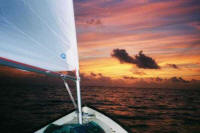
|
I sailed into the sunset on northwest sea breezes and following
seas, dodging the large sunset cruise boat out of Fort Myers. There were many
small fishing boats about four miles offshore, and I gave them wide berth. My
planned route avoided the buoy-to-buoy route taken from the GPS points provided
by the chart because many power boats use these ready-made routes. I would pass
by offshore buoys from time-to-time, using outer buoys at passes as alternate
waypoints. This gave me occasional confirmation of my location.
Around 9 PM the sea breeze died. I turned on the bright stern light
and fell asleep on the cushions on deck. Within an hour, the weather pattern
easterlies filled in at about 15 knots and I was off again. After the moon set,
the night was very dark, and the seas built to around four feet. I was now
committed to the offshore route since entering an unknown pass at night would
be unwise. It was still a bit frightening for a lake-based day sailor, but the
miles were passing easily under my keel.
There was a haze along the shore, making the high rise resorts of
Naples seem unreal, but the sky above was clear. Orion was high overhead, and
constellation Columbus stayed ahead of me until I turned the corner at Cape
Sable. Shooting stars reminded me of the Columbia astronauts, and I said a
little prayer for them and their families. South of Naples the shore lights
diminished significantly and boat traffic stopped completely.
I crossed the entrance of Big Marco Pass at 4 AM and continued on
toward Cape Romano Shoals. My original plans had been to go inside at Big Marco
because of Greybeard's tales of big waves on the shoals last year.
ZigZagWanderer, who does fish research all over the area, assured me that such
waves were typical of a strong northwest wind, but that there is usually no
worry. I was now sailing on a 10 knot northeasterly, so the shoals were
protected by Marco Island. I turned toward Indian Key when it was due east and
crossed the shoals. My anxieties were allayed as I encountered no waves above
two feet and the sudden warmth of a rising sun over the Ten Thousand Islands.
Though the high rises of Marco loomed on the northern horizon all the way to
Indian Key, I was now in the familiar Everglades and away from development for
several days. I also had new confidence that I could complete the Challenge.
My confidence would be short lived. The wind continued to shift to
the east, making it impossible to fetch Indian Key on one tack. By 10 the wind
had died completely and the bay turned glassy – Indian Key and the entrance to
Checkpoint 3 at Chokoloskee was a tantalizing 6 miles to the east. The sun was
oppressively hot. I realized that my sandal-shod feet were burned to a crisp
and put on a pair of the heavy wool socks I had saved for cold weather. Then I
discovered a rash on the back of my hands, seemingly caused from wearing wet
sailing gloves for over 24 hours. From there my mood spiraled downward.
In the final analysis, the success of a boat like mine, which errs
on the side of sailing efficiency and sacrifices paddling efficiency, depends
more on the vagaries of the wind than on the skill and fitness of the skipper.
Calm or light winds could still frustrate the possibility of a finish. What
about my seventh and eighth graders who put up with substitutes so that I could
be here. What about the deans who had enabled me to compete in this challenge?
What of my fellow faculty members who have helped so unselfishly? I was hot,
stinky, miserable and frustrated almost to tears, and I could do nothing to
improve my situation. Patience is the lesson of sailing.
Sometime in the early afternoon I began to see cats paws of
extremely light wind on the water. I broke out the oars and rowed from one
wrinkled area to another, sailing for a few minutes on each hint of a breeze.
After an hour or so, these westerly onshore breezes filled in to about fifteen
knots, and I surfed past Indian Key on an incoming tide. The wind stayed behind
me for the whole twisty passage of Indian Key Pass.
As Chokoloskee Bay opened before me, I turned right out of the
channel and began a screaming beam reach across the Bay. I was kicking up a
small rooster tail and the GPS showed 9.5 knots. Just before the beach at
Chokoloskee, I hove to, pulled up the leeboard and rudder, threw out the
anchor, and eased out the rode until just shy of the checkpoint beach. The tide
was coming in, so I had no fear of grounding.
I signed in at 3:30 PM. I had been on the boat for almost 36 hours.
I rocked as I walked like a drunken sailor. I had covered 70 miles in the 24
hour period from Boca Grande to being becalmed off Indian Key. The GPS odometer
read 180 miles. I got a diet coke and ice cream sandwich at the Outdoor Resorts
store and returned to clean up and straighten up the boat.
I was no longer in last place. Now I was in the middle of the pack.
On the beach were Greybeard and ChefRamen (a father-son team who were second
last year in their schooner-rigged Kruger canoe), and kayakers Porky (a very
fit Sarasota firefighter who was beached by the storm last year), DrKayak
(Porky's paddling partner), and SnoreBringsGator (Bronx-raised and very
Everglades savvy). Race Manager SandDollar and all the competitors were very
encouraging, and my spirits soared. We all had dinner together at J.T.'s, the
legendary island restaurant, and returned to the beach to catch the 6:30
outgoing tide. WaterRose (soon to be the first solo woman to complete the
Challenge), ZigZagWanterer, and ManitouCruiser and Techmon (Manitou
manufactures the Kruger canoes. He has finished every Challenge he has entered
– 4 – and Tchemon is his fiancé and a finisher in the Okefenokee Challenge.)
had all arrived while we were at supper. I also met Mark, a part time
Chokoloskee resident who sails his Sea Pearl in the Everglades. But no time to
talk now – have to use the last of the light to take the complex Chokoloskee
Pass out to the Gulf.
Chokoloskee beach was now a lee shore, so I had to tack off it to
gain the yardage to get around the tip of the island. I had to heave to once to
shake out my reefs so that the Sea Pearl would point high enough to make the
route. Luckily, it was high tide and shoals were covered. I was fortunate to
have scouted this pass last Thanksgiving, so I had the turns saved in the GPS
(and on a hard copy in case it failed). After a little tight tacking, I was
out! Then it was just a close reach out to the Gulf.
I was conflicted about what to do now. I was tired, but I did not
want to leave any wind unused. I sailed off toward my first waypoint at
Pavilion Key Light. Near the light, the wind died, and I gratefully fell asleep
on the deck.
I was graced with a full eight hours of sleep. The wind came with
the dawn at about 5:30. After breakfast and preparation, I was sailing by six.
The wind was southwest at about 10 knots. I sailed with only two tacks through
a beautiful, crisp Everglades day. I saw one sail behind me near Highland
Beach, and I slowed to check on SnoreBringsGator near the mouth of Shark River.
The wind died around 6:30 PM, and I anchored in the little bay between
Northwest Cape and Middle Cape Sable.
Dolphins fed and blew all around me as I prepared supper and
watched the sunset. The mosquitoes quickly swarmed, and I raised the cockpit
camper cover for the first time before eating supper. I lay down sweaty on top
of my bag around 7:30, and I could hear the dolphins clicking to each other
through the hull. Just before falling off to sleep I thought, "Wouldn't it be
fun to do this trip again when I'm not in such a hurry?"
|
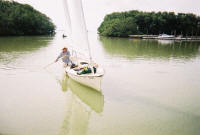
Arriving At Flamingo
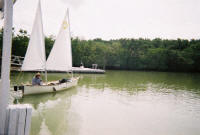
Departing
|
At 3:40 AM I was awakened by the hint of a breeze. I quickly stowed
the gear and got underway with a granola bar for a snack. In a light 5 to 10
knot southeast breeze, I began to tack toward Flamingo. It took me six hours to
cover the 6-7 miles into the final checkpoint at the Flamingo marina. I arrived
at 10. I was cheered by Waterbuoy (WaterRose's boyfriend) and ThereAndBackAgain
(a wonderful wheelchair-bound man who was the first kayak and second overall in
the 2001 Challenge).
I didn't have much time to talk. During scouting at Thanksgiving I
found that an outgoing tide through Tin Can channel made the route impassable
by my boat, so I spent only 19 minutes ashore (getting extra water, coffee, and
Fig Newtons at the store, signing in, and visiting a real bathroom). I left
with great confidence – I could travel only ten miles a day across Florida Bay
and still finish before the deadline.
Winds were light going out of Flamingo and the sun was hot. I
wondered if I would have to anchor at the entrance of Tin Can channel and wait
for the tide to change again. What a difference between this and my scouting
trip at Thanksgiving – then I was zooming along at a reach on northerly winds
with five dolphins escorting me across the bay; today I was barely moving,
trying to pinch up on a five knot southeasterly breeze.
Florida Bay is a large, shallow expanse, often only a foot deep,
its aqua waters punctuated by mangrove islands. Ospreys are everywhere, and
each seems to have a fish in its talons. Large tarpon ply the shallows. It
looks just like the pictures in the flats fishing ads. The finish is about 30
miles due east of Flamingo. The trick is to find the entrances to narrow
passages between deeper bays. Everything else is too narrow to negotiate in
most of the Everglades Challenge boats. Tides through these channels,
especially with the wind pushing the tide, make passage almost impossible. Good
vertical light makes finding one's way easier, and there are no lighted markers
to aid a nighttime passage.
As I entered Tin Can channel on a close reach, I noticed the GPS
speedometer move up to 7 knots – I had caught the tide! The first leg was over
quickly. Each marker post was topped by an Osprey, and they each peeled off as
I sped by. Halfway through, Tin Can takes a 90 degree turn and bears southeast
– right into the teeth of the wind. As I made the turn, progress stopped.
For a frustrating two hours, I alternately tried to row against the
current and to tack in the narrow, shallow channel. My only bad words during
the whole trip were said here. Two hours for one mile sure screws the velocity
made good! But I finally made the turn and close reached for the open water in
the bay before Dump Keys.
The Dump Keys and the bays on either side went fast. As I made the
turn for the Twisted Mile channel around the end of End Key, I realized that
Twisted Mile would be straight into the wind. Remembering the effort in Tin
Can, I decided to abandon my plan and take the channel on the map that led
south toward the bay to the east of the Buttonwood Keys.
Soon I saw a row of sticks in the water and heeled over, close
hauled for the channel. Soon after I reached hull speed, the leeboard and
rudder dug in and I ground to a halt. The sticks I saw were planted mangroves.
I got out the binoculars, but I could not find the channel. I decided to get
out and drag the boat across the shallows.
For about a half mile, I alternately sank into the marl and walked
on bottom vegetation, dragging the boat with rudder and leeboards up. Twice I
had to stop and dig out my sandals from the gooey gray calcareous marl. Several
other times I had to grab onto the bow of the boat to keep from sinking above
my knees. Then, thankfully, the bottom dropped away, and I hopped aboard and
began to sail again.
The channel just north of Calusa Key was easy to find, and I sped
due east across the bay toward Jimmie Channel. The wind was now about 15 knots
from the southeast, and I could easily sail east or south. The sun was racing
toward the horizon to my stern. In the light of a spectacular sunset, with a
hot pink sky with orange clouds, I turned into the mouth of the Jimmie Channel
heeled hard over. The water was the beautiful aqua color you see on the
Patagonia flats fly fishing ads.
The wind and tidal current were against me. The opening markers for
the Jimmie Channel stood still as the water rushed past. I was going nowhere!
The GPS said that the finish was just over ten statute miles east. I could
taste the end. This channel and the one more by the Manatee Keys and I was home
free!
I jumped out of the boat and sprinted across the flats with the Sea
Pearl in tow. Darkness fell swiftly as I jumped back aboard and searched for
the opening of the Manatee Key Channel. I was getting a little frantic now, and
I needed to eat and put on warm clothes. With the sun below the horizon,
darkness came swiftly, as did the evening chill. I threw out the anchor and
made myself go through my night preparation, including having something to eat
and stocking the cockpit with water and snacks for the night. The wind held
strong from the southeast and the Manatee Channel still could not be found.
Balancing my excitement and fatigue, I took out my flashlight, the
chart, and the GPS. After figuring out exactly where I was, I plotted tacks to
the south and east to skirt a couple of shoals and get to the Intercoastal
Waterway. I would sail on each tack until I reached a predetermined latitude or
longitude, then tack. I set up the running lights because I would encounter
other boats on the Intercoastal, and I turned on the VHF for the same reason. I
was off again with a new plan, well fed, warm and confident.
|
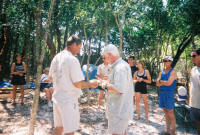
Congratulations RidgeRunner!
|
About 10 PM I reached the Intracoastal with all its lights, and
took off north and east for the finish beach. I sailed onto the finish beach
just after midnight Thursday night. As I threw out the anchor and stepped of
the boat, CrazyRussian handed me a beer, and I was cheered by Greybeard,
ChefRamen, and Matt.
I was elated. 5 days 17 hours and 30 minutes. 11th overall and 6th
in Class 4 (4th solo Class 4 boat). I had been on the boat almost every moment
since Placida almost 4 days ago. I couldn't walk too well, even before the
beer, but I was elated. All my wonderful friends and competitors put up with my
tales for over an hour while I unwound. Then a hot shower and blessed sleep.
I had come a long way from last place at checkpoint one. There were
times when I wondered if the wind would allow me to finish before the Sunday
noon deadline. I was happy. The next two days were spent on the beach at the
campground, making new friends as each competitor came in. Listening to all the
wonderful stories as, one after another, all the boats still on the course
finished and went through the same decompression process. We all admired Matt's
winning rig and asked him a thousand questions.
All sorts of people in all sorts of boats. All sorts of solutions
to the challenges of an ideal expedition craft. We all reflected on what we had
learned and speculated on what our solution would be next year with all this
newfound knowledge. What wonderful people! What wonderful fun! Thanks to Chief,
Sandy, Dennise, Russell, and all the other volunteers who made this event
happen!
Reflections: All boat design is a compromise. Boats that turn well
will not track as well in a straight line. The fastest boats will not carry a
heavy load or be as stable. The best rowing boat will not be the best sailing
boat. All Everglades Challenge boats are solutions to the problem: How do I
safely and swiftly complete the Everglades Challenge in all sorts of different
weather conditions? This year was good for sailing boats and there were no
strong fronts to drive anybody ashore. My boat was a very good sailor, but, to
do better, I will have to be able to move the boat in still air. The first try
will be a yuloh like Matt's.
This is the finest collection of people I have encountered. I guess
that the race is quite a filter itself. It takes a special kind of person to
spend all the hours in planning and training and to have the tenacity to see
the project through to a finish. These folks are problem solvers – they focus
on the solution instead of the problem.
We are blessed to have Chief, his wife, Sandy, race manager
SandDollar, and volunteers ThereAndBackAgain, KonTiki, Harold Waller (CP 1),
Skip Peerless and all the other folks who made this happen. They are all
volunteers. Only in America!
© Doug Cameron, 2003
Capilene® is a registered trademark of Patagonia.
|